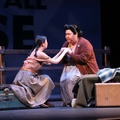Part 1 >>
In a July 1941 meeting, representatives from both the Department of Justice and the Department of War formalized injunctions that barred enemy aliens from restricted areas such as the Canal Zone, and forbade possession of firearms, ammunition, cameras, short wave radio receivers, and signaling devices. Fishing boats frequently contained these items, raising suspicions that the fishermen could assist Japanese submarines. The United States’ House Committee on Un-American Activities claimed that federal investigators possessed a map, allegedly distributed among Japanese aliens, which contained vital military information on the Panama Canal, justifying fears of a “fishing boat menace.” The map and the confiscation of restricted devices confirmed for the Americans that the Japanese were engaged in fifth column activities.
Even Amano would concede that his presence in the Canal Zone looked fishy. Sometime before the bombing of Pearl Harbor, he had sent his wife and children to Japan and could have attended to business elsewhere in Latin America but, “Just my luck, I was in Panama when the war started. When I thought about it later, I knew I was never going to be treated like a regular prisoner.” On December 7, 1941, Panamanian police arrested more than 100 Japanese men along with other Axis nationals.
Amano recalled that Sunday, December 7 dawned sunny and mild despite Latin American superstition that held that “if the seventh day of the month is on a Sunday, it’s a very bad sign, Sieté Domingo.” Amano had been out for an afternoon drive when fifteen armed policemen burst into one of his properties, which served as a dormitory for the department store employees. Only two of the several dozen workers were women: the manager’s wife and a governess/housekeeper. The police loaded everyone, some wearing only their underwear, into paddy wagons and thoroughly searched the house for Amano. The women were allowed to hold onto their handbags but the men could bring nothing with them.
Amano remembered driving past a newspaper vendor holding up a fresh edition with the headline, “Guerra Con El Japan” before entering a checkpoint manned by four or five police officers, culling out the Japanese. He managed to drive through the roadblock but, anticipating arrest, went home to pack a small bag. Preferring the dignity of cooperation over capture, Amano turned himself in to Police Headquarters. He recalled that the police chief pulled out a chair for him and quickly telephoned a colleague to call off the search for Amano. The chief walked with him to Chorrios Jail, one block away. Amano found that “all Japanese in Panama were there. Mostly barbers.” He reported that the women and children had also been detained, held separately from the men. After three days,
we stepped out of a dark jail into the blinding sun and almost got dizzy. The American solders, at both ends of our group, stood at attention. We marched through them, between bayonets. They loaded ten prisoners to each truck with two American soldiers pointing guns at us. The Panamanians saw and started to come around and watch, like we were performing a strange show. The trucks moved and as we headed off, someone in the crowd of Panamanians said “viva el Japon.” We didn’t expect that kind of remark. We were very emotional and the shout gave us a bright uplifted feeling as we were sent to the Canal Zone.
The approximately one hundred male prisoners still did not know the fate of their families as the trucks rolled towards Balboa Harbor. These men would not know the detention location for the women and children until April, 1942.
Although a majority of historical sources placed the Japanese internment facility at Taboga Island, Amano drew a distinction between that location and the military camp at Balboa. He described Taboga Island, also known as Isla De Flora, as a beautiful seaside resort of swaying palm and tamarind trees outlined by a white sand beach. Amano hoped that his group could swim and enjoy the island just as the German internees during the First World War had been allowed to do. The road leading away from jail forked with one route to the island and the other to a concentration camp. “Alas, the truck turned left. My Taboga dream was gone.”
Amano described a makeshift camp of unassembled tents, boxes of canned goods piled in an open field, and no latrines. Barbed wire surrounded the area, and soldiers patrolled with machine guns. American soldiers commanded the prisoners to set up twenty tents and place eight cots in each tent. The group had not eaten in three days, so the first camp meal of potatoes, beans, bread and half a cup of cold coffee seemed extraordinarily delicious. The fine meal did not predict future conditions as months of harsh labor and frightening uncertainty followed.
Within a few days, Italian and German prisoners arrived, and, with them, the first indications of divergent treatment for prisoners of different Axis nationalities. Amano recalled,
the Germans were on the other side of a double fence. In secret, we tried to get news about the war from the Italians. We never communicated with the Germans but always worked with the Italians. Our confidence was boosted. We started to get assigned easier jobs. We acted like we were superior to the Italians and we were feeling overconfident.
The arrival of wounded soldiers from Pearl Harbor to Gorgas Hospital in Panama triggered a change of attitude among the Americans. Amano reasoned, “When the soldiers saw their own buddies wounded and in terrible shape, their morale or their desire to fight increased. Then their reaction was, ‘I hate the Japs’ and that came down on our heads. We got punished for Pearl Harbor then and there.” Amano suggested that the U.S. sent wounded soldiers to Panama in order to reduce the anxiety and fear of the American public that could have led to chaos after the Pearl Harbor attack.
Amano also noticed a difference in attitudes between a newly arrived group of draftees and the former group of enlisted soldiers. He attributed the increased brutality of the draftees as coming from resentment for missing their sweethearts and the easy life of an American civilian. He concluded:
Not only did they resent the Japanese, but also they saw the wounded soldiers and were ready to explode. We took the brunt of their anger. We noticed immediately that the new group of soldiers was different. They stared at us with hate in their eyes. All the bad jobs were assigned to us, much worse than those assigned to the Italian group. The Italians looked at us with pity because we had to work much harder.
Amano reported months of physically demanding manual labor such as digging latrines and picking up rocks, and even instances when soldiers hit and kicked them. Many of the Panamanian Japanese were middle-aged, and the harsh conditions took their toll on the weakest.
Amano also described the perverse enjoyment some soldiers took in issuing orders. He recalled one incident that required ten prisoners to dig a hole measuring six by nine by four feet deep. Informed that the results were off by two inches, the prisoners had to refill the hole, tamp down the soil and start again. “They just wanted to make us tired.” Forty-three years old at the time of his capture and accustomed to giving orders, Amano learned to accept orders.
© 2010 Esther Newman





